Our Isuzu 4×4 truck camper (NPS 75-155) is four years old now. We’ve been living in it full-time for 2½ years… less a few long stints at home, which I’ll get to soon.
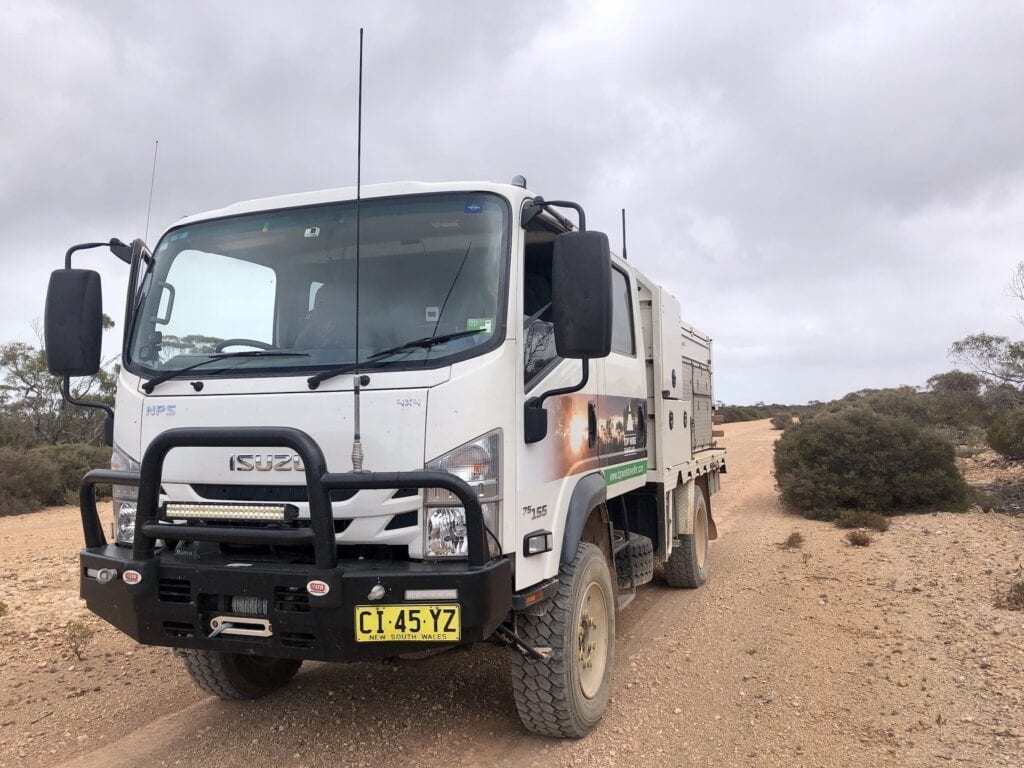
So, what’s happened in the last 12 months? Has our NPS been reliable and lived up to expectations?
By the way, here’s the 3 Year review of our truck you might be interested in.
A Few Disruptions
The last 12 months have been pretty badly disrupted. In that time, we’ve travelled less than 20,000km. I know, not good enough…
The odometer is at 128,000km after 4 years. Hardly big kays when you average it out over 4 years!
We’ve had a few unforeseen breaks over the last year… a long 4-month break when we were selling our house and downsizing, a 5 week break when we were caretaking at Wild Deserts and then of course, lockdown due to the pandemic for over 3 months.
In effect, we haven’t travelled much at all this past year. Although, we did manage to fit in a few awesome trips…
“Where Has the Truck Been in The Last Year?”
Here’s a few places:
- Volunteering at the Big Red Bash,
- Walkers Crossing Track from Birdsville Track to Innamincka,
- The Cut Line from Tibooburra to Bourke,
- The Nullarbor including the Old Eyre Highway and Cook,
- Kalbarri, WA, and
- A few excursions into Corner Country to Wild Deserts.
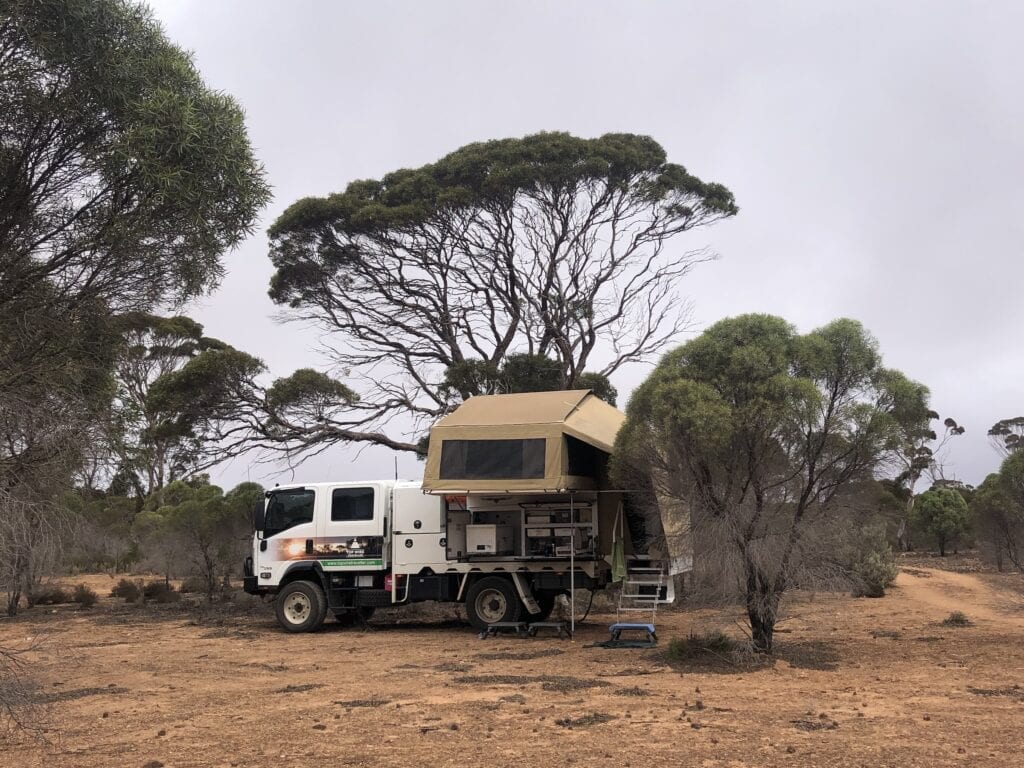
So, we’ve still managed to get around!
And the truck’s had its fair share of corrugations and rough dirt roads.
“Any Breakages?”
No, nothing at all.
“Any Repairs or Replacements?”
Just two new tyres. We replaced them early, at just on 60,000km. Why? Well, we were heading to NSW Corner Country in late December to caretake at Wild Deserts all of January.
The tyres were marginal, although we could easily have squeezed another 5,000km out of them.
Rough dirt roads combined with air temperatures up to 48°C definitely aren’t kind on tyres… especially with ground temperatures pushing 70°C.
I decided we were better safe than sorry, and replaced the two spares.
We didn’t need them of course! Months later when I rotated the tyres, the two new spares ended up on the front.
It turns out the tyre dealer used internal balance beads, which are worse than useless on a truck tyre. Not surprisingly, the tyres wobble and bounce until we get up enough speed and everything balances itself.
So if you’re ever wondering whether to try balance beads… don’t!
And when you get new tyres fitted, make sure to specify you want them balanced with external weights.
We’re still seeing strange wear patterns on the front right (before I rotated the tyres). After lots of investigation and a long yarn with Steve from Toyo Tyres, it seems like these small trucks are notorious for unusual wear patterns.
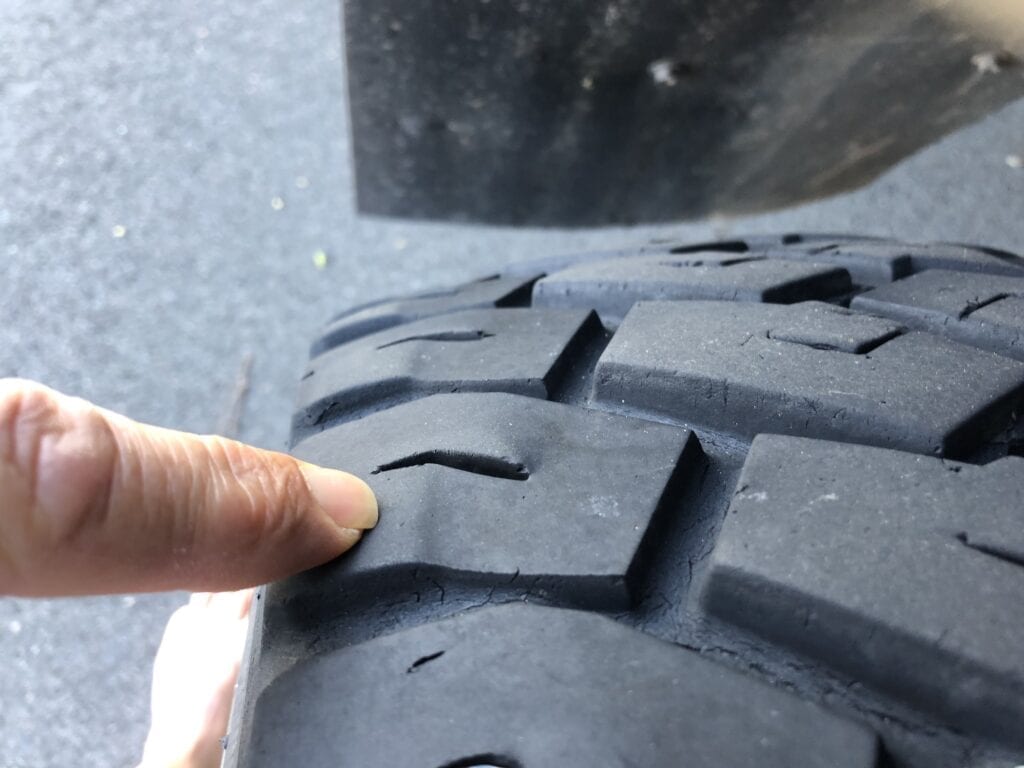
Another thing that might have contributed… these tyres have done more long-distance bitumen driving than we’d normally do.
We drove across the Nullarbor, around South-West WA, up to Kalbarri then back across the Nullarbor. Much of this was on bitumen, since unseasonal rain in WA closed many of the dirt roads we were planning to do.
The best way to keep tyre wear under control? Rotate them every 10,000km. Steve from Toyo also said to get a wheel alignment, however I haven’t got around to it yet. Find out more details about tyre pressures for light trucks here.
“What Have You Added?”
We recently bought a couple of Airhawk truck seat cushions. (Note: We’re not affiliated with Airhawk in any way). I keep dreaming about fitting new suspension seats in the front for driver and passenger. Realistically though, it’ll probably never happen.
One reason is the seat height. Suspension seats add height to the seat base and we’re both pretty short. So I don’t really want our legs swinging freely like two toddlers on a lounge chair!
Honestly, we’re not too worried about the seats. Yes they could be better, but I suppose we’re used to them now.
We’ll give these seat cushions a try. They have a series of air pockets which you inflate with a hand pump to suit your weight. I’ll let you know how they go.
“What Other Mods Are You Planning to Do?”
I’m having a few crazy thoughts about ripping everything out of the back seat area and starting again.
This all started from us trying to figure out a way to carry two mountain bikes. We can’t have a rear carrier, as our rear overhang would then be more than 60% of the wheelbase… the RMS would have a field-day!
And I don’t want them on the roof. The truck’s tall enough already.
So, I had a wild idea about getting rid of the top storage box and moving all its contents inside the cab. Then I could fit the bikes plus a wood box plus the second spare (now inside the bottom storage box) to where the top storage box is now.
This of course would mean building a whole new storage system and relocating the dual battery system. Hmmm…
Just like the suspension seats, I’ll probably never get around to it. But who knows? It’s worth considering.
“Any Problems?”
Just one slightly puzzling experience.
I said earlier we spent January slowly cooking from the inside out, while caretaking at Wild Deserts near Cameron Corner. A “cool” day was mid-30s, a hot day was 48°C.
We left there in early February and explored Eyre Peninsula in South Australia. Temperatures were still crazy-hot. When we arrived at Ceduna, I noticed what looked like large amounts of power steering fluid splashed all over everything.
I checked the reservoir (behind and above the front wheel), which was still full. It had indeed been leaking, but the reservoir wasn’t cracked or damaged and all hose clamps were tight.
Oil leaks always look worse than they are… the smallest amount of oil has a knack for spreading out over every available surface. The volume of fluid that had actually escaped was probably minimal.
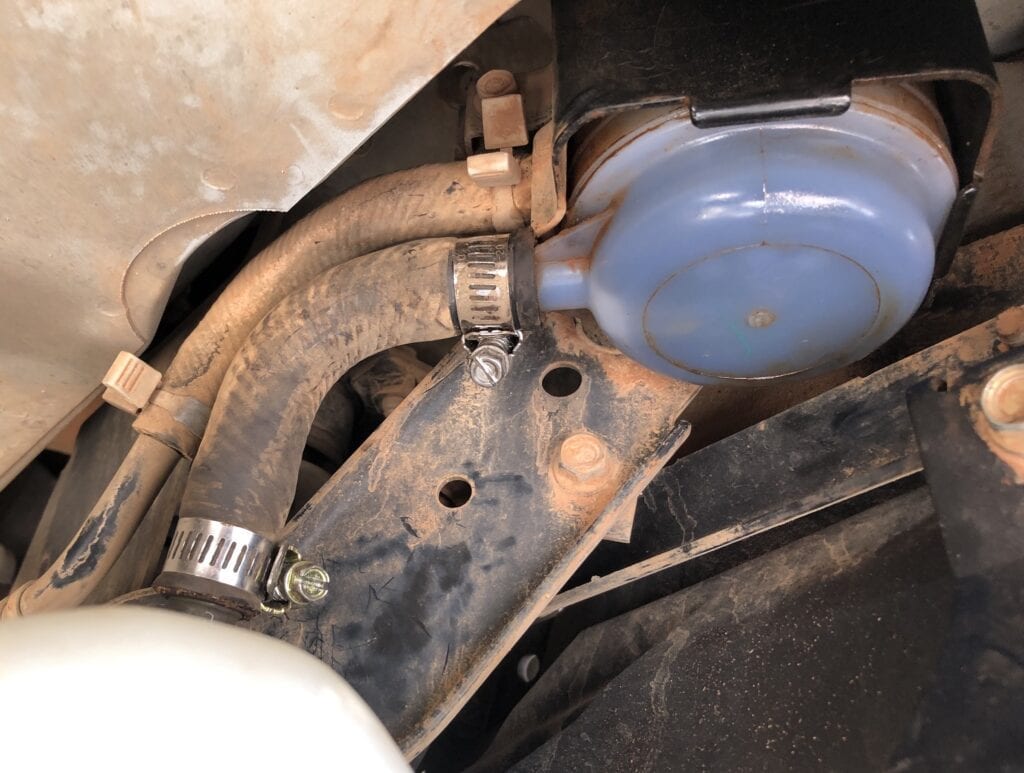
After a few phone calls and a visit to a local diesel mechanic, we decided all was well and headed across the Nullarbor.
The truck was booked in for a service at Albany Isuzu anyway, so they checked the power steering system, flushed it and filled it with new fluid.
We never found the cause. All I can think is maybe the reservoir was over-full and the extremely hot days meant the fluid expanded enough to pop the reservoir’s filler cap slightly.
Or the filler cap might not have been on properly. We’ll never know.
None of the Isuzu service people I spoke to had seen this before and it hasn’t happened again. The power steering is working perfectly and there aren’t any strange noises coming from the pump.
It’s a mystery.
“Would You Buy Another One?”
Definitely! An Isuzu 4×4 truck is an ideal option for a tourer, overlander, truck camper, expedition vehicle… or whatever you want to call them!
If I was to start over? I’d seriously consider a single cab with a large walk-in box or pod behind the cab, instead of the dual cab.
The dual cab is great for extra space where you can securely store your gear. However, there’s a lot to be said for the convenience of being able to tilt the cab.
There’s a few things hiding under the floor of that dual cab (like the power steering pump and an exhaust brake switch on top of the gearbox for example) that are almost impossible to get to.
Yes, the dual cab can be tilted for major repairs. But it would be good to have that access on hand all the time.
Other than that, our Isuzu NPS has proven why they are so popular as mine and emergency service vehicles. They’re tough and reliable.
We’ll be hanging onto ours for a while yet!

Get your Traveller’s Guides
… and a whole lot more at our FREE RESOURCES Page!
Any questions or comments? Go to the Comments below or join us on Pinterest, Facebook or YouTube.
Any errors or omissions are mine alone.
Go here for more Reviews on our 4×4 Isuzu NPS truck.

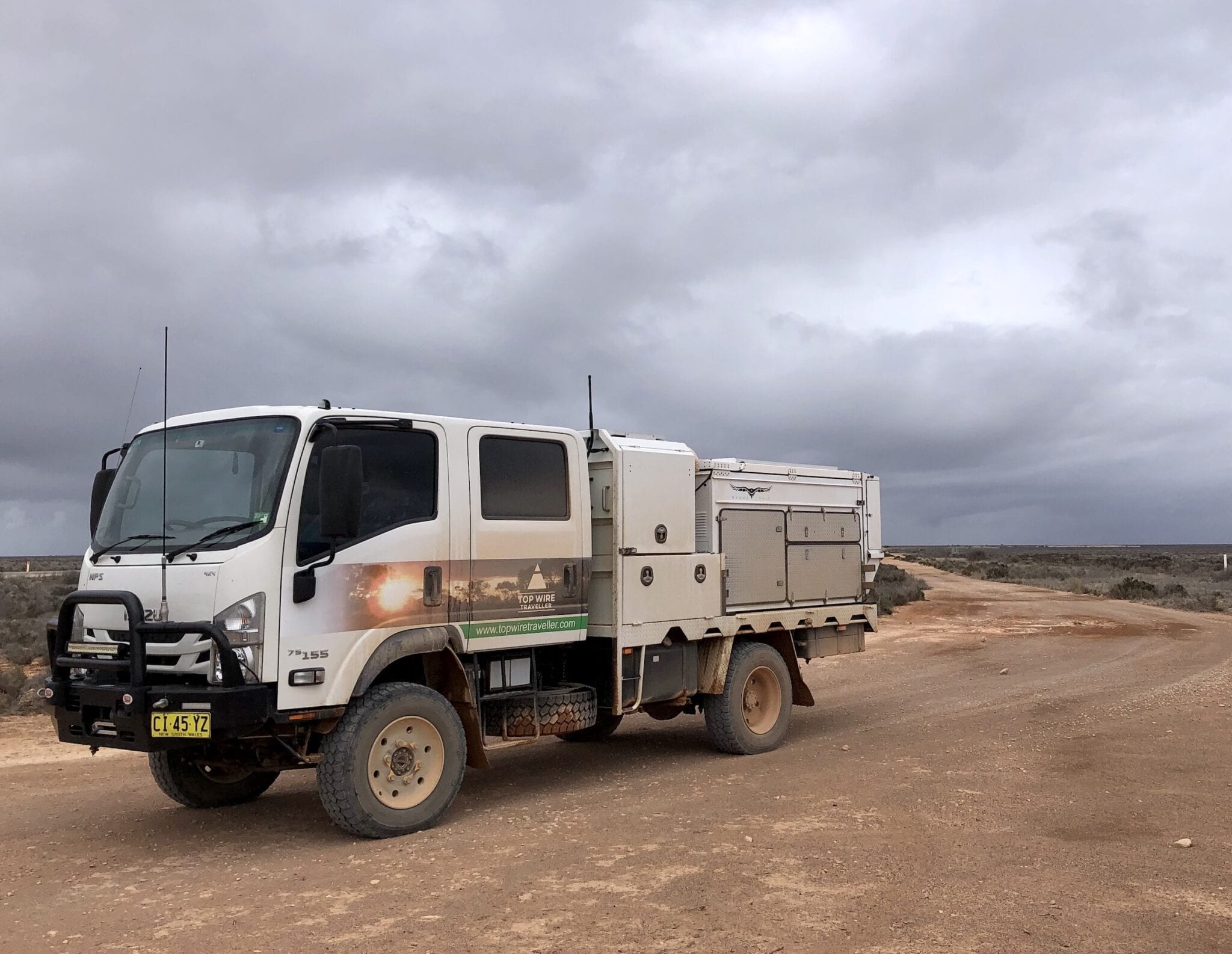
Hi Andrew & Peta,
Have you considered folded bikes that reduce to a large brief case?
A mate of mine does very arduous and long trips on these, mainly on bitumen though. He mainly cycles the minor roads for a more enjoyable trip. He’s done Adelaide-Canberra-Sydney and Sydney-Melbourne, Melb-Canberra, and many other trips all on a folded bike. He lent me his spare for my first cycling trip with him and we did Cooma to Eden over about 4 days. Lots of fun! We camped in the bush on a couple of nights. I have done some dirt track riding on it and I can’t see why it won’t work. Sure, it does not have the high wheel base so you might need to walk the really bad bits and yeah… they are not as cool as a dirt bike but very functional. I can put you in touch with him. Great reading your stories.
Regards,
Madan
Hi Madan,
They are epic journeys on a folding bike, wow! Cooma to Eden’s a pretty challenging trip too, although at least you didn’t attempt it from the other direction.
We’ve had a folding bike for a while, strapped into the back seat. It still takes up heaps of space though. Also we’ve had a ridiculous amount of punctures, mainly from burrs. The problem is, tough tyres aren’t available for the small rim size. So we’re a bit over the whole folding bike experience unfortunately.
Thanks for telling us about your mate’s (and your) adventures. I can’t imagine riding that far on a folding bike!
Cheers, Andrew
Hi, thank you for such a brilliant post. I have been reading some blogs that gives me more knowledge about this topic Isuzu 4×4 truck. I must say this is one of the best among them. You have done a great research for I feel, thanks for sharing.
Thanks! Cheers, Andrew
Hi guys,
Just read your report for this year and I would like to comment on a few things.
We traveled for 3 years towing a 3.5 ton caravan in behind my nps 13 model weighing 10 ton. Maxed out at all times. We traveled 125,000 kms over the 3 years and 100 thou with the van on. We have the same tyres as you(not impressed with them approx 45,000 was normal for us and 5 flats 3 were failures. Not one on the van.
Now your power steering fluid I have had the same problem and we also put it down to the heat. We were in sa at the time in late January and was bloody hot. Never did find the leek and when we got back to Queensland I changed fluid and never had the problem again. As for your tyre wear that photo you showed is how mine has been from new. It has had many wheel alignments all over aus and no one has ever got it right. I have given up and this will be my last set of Toyos. We have had many talks with toyo reps and first set of tyres were replaced under pro rata warranty but after that toyo blamed wheel alignment and guys blamed toyo. We do and have done a lot of blacktop driving and atw thinks that could be the problem. Seriously thinking of going 17s just to try. Like yourselfs love our truck and can’t see us selling anytime soon.
All the best
Kevin
Hi Kevin,
Your tyre experiences are interesting. Like you, we’ve had this wear pattern since new. We get around 60,000km from a set if we rotate them every 10,000km. To date we’ve had zero flat tyres or blowouts, and we’ve done some serious tyre-shredding roads. I wonder if your pressures are right for the respective axle weights?
Personally, we won’t be moving away from Toyos simply because they are so bullet-proof for us.
I’ve spoken to a lot of people about the tyre wear (including Toyo). They all say the same thing… small Japanese trucks are renowned for chewing out steer tyres and the off-road tyres we run are even more prone to this type of wear.
I agree with ATW about blacktop driving. We’ve found exactly the same thing. I’m going to start rotating the fronts from one side to the other and see how that goes (rather than a full front-to-back rotation). From what I’m hearing, the 37s and 17″ equivalents also get the same weird wear patterns, plus they don’t last as long as the 19.5″ Toyos. Worth thinking about before you spend the money…
It’s interesting you’ve had the same power steering overflow issue. It happened to us in SA too! Hopefully it was a one-off for both of us.
Enjoy your travels.
Cheers, Andrew
Hi Andrew and Peta.
I’m researching one of these vehicles and stumbled onto your sites. Great stuff and simply fuelling my fire and desire for one of these trucks. I’ve got plans drawn in my head as to hiw I’m going to build the back section, though I’m loving the dual cab, I’m thinking a single cab may be more desirable for storage practicalities too.
Tyre wear problem solved. Don’t waste your money on wheel alignments any more. Nobody understands the geometry of vehicle alignments. These vehicles are built overseas and are designed completely different in the front axle geometry. The front different need to be either slightly bent or shimmed to correct the alignment angle. The will laugh at you and say you’re mad. I’ve proven it on another isuzu light truck. Funnily enough, a reputable truck aligning specialist listened, researched and FIXED the alignment issues on my uncles truck.
Keep up the good work, and I’m hoping by the end of this year, I’ll be in mine 👍🍺🍻🏝
Hi Craig,
Glad you’re enjoying our articles, thanks for the feedback!
It’s always a difficult choice between dual cab and single cab. They both have plusses and minuses.
Your info about the wheel alignments is interesting. I know there are places that bend the front I-beam axles on 2WD trucks. The people who did our alignment used shims. So I’m curious about how much difference the alignment make sin the long run. Time will tell.
Cheers, Andrew
Gday Kevin,
I was just wondering how the Isuzu coped with towing your van at 3.5 tonne. I have a 28 ft.
full off-road van which is around 4000 kg loaded. It tows well with a 79 series dual cab cruiser, but obviously I have been exceeding the GCM of the vehicle (6900 kg) and max tow capacity of 3500 kg.
I have ordered the 2021 nps300 Isuzu dual cab 4×4 which now has a tow capacity of 4500 kgs.
ATW are taking care of all the upgrades required for some off road travelling.
The truck itself won’t be running very heavy. It has a GVM of 7000 kgs ( reduced from 7500 kgs due to 17” super singles).
Loaded I have estimated around 5300 kgs
My main concern is engine power. Land cruiser has a strong and gutsy v8 compared to the small Isuzu 4 cylinder.
Did your Isuzu struggle to tow your van, was it sluggish on hills? Did you have a chip or remap done.
Look forward to your response.
Regards,
Paul.
Hi Paul,
We don’t tow a van, but are always loaded at around 6.5 tonnes. It’s slow and sluggish on hills, however we don’t have a chip or remap. It did have a chip for a while (moderate increase in power and torque), but it caused a few strange problems. So I took it out a few years ago and have run at standard specs.
I don’t really like the idea of a remap due to potential long-term reliability issues. We’re more interested in reliability than performance. Each to their own, however that’s my view. There’ll always be a trade-off between extra power and reliability.
There’s a good reason why Isuzu rate these engines at those specs. So I’m not keen to go any higher with a remap.
I’ve heard of blown gearboxes, diffs, clutches, head gaskets and damaged injectors due to remaps. As I said though, each to their own.
There’s no comparison between a 79 series and an NPS. The 79 has huge amounts of torque, but the NPS certainly doesn’t!
Hope this helps.
Cheers, Andrew
Hi Andrew.
I just saw this thread and thought I might contribute.
First off. I have to say I’m a huge fan of the Toyo tyres. We got 60000km from our first set and like you, could have got another 5 or 10 but with less traction in mud than preferred. Like you, after about 50000 km I also noticed scalloping, particularly on the outer tyre lugs, which I initially put down to needing a wheel alignment. However, when I went to get it done the problem was instead the tie rod arm, which had become sloppy on its knuckle bushes. A $200 replacement part later – problem fixed. My new set of tyres are wearing true. Shame they aren’t importing them any more. I have had only one tread puncture (a stainless bolt) in the whole time and that’s included rough terrain in northern WA, NT, central aus, far north Qld, Vic high country and lots of other places.
On the topic of our performance chip. Again, like you ours played up, putting us into limp mode in very inconvenient places. The supplier was Tunit and the owner guru who is based on the Gold Coast worked out the problem was the increased fuel flow causing the spring-loaded valve in the diesel fuel return line to act up and hence cause faults back to the ECU, with the engine caution light coming on and rough idle at start up and eventually limp mode. He put in a heavier spring and problem solved. The performance difference is substantial and we have had no further problems 40000km later.
Cheers
Simon
PS. Ours is a 2018 NPS and we typically weigh in around 7.3T fully laden.
Hi Simon,
Thanks for that information, very helpful. The worn tie rod makes a lot of sense. I’ll have a look at ours. And yes, the Toyos were an incredibly reliable tyre.
Your experience with the chip is slightly different to ours. It played up straight after services (by Isuzu) both times. I suspect they may have done a software update which conflicted with the chip’s program. However, your spring issue makes sense too.
But we never had any fault codes and no rough idling. It would start then stall within 30 seconds, as if it was starved for fuel (which I think it was). It would restart straight away and run normally. But then twice after servicing, the truck wouldn’t start next morning at all. But as soon as I disconnected the chip, it started straight away. Our chip is in a box at home – I’m not game to fit it again! But we do miss the extra (modest) power and torque.
Cheers, Andrew
Was just wondering how a 75/45- 155 Isuzu 4×4 would handle towing a 3.500 kg van
Hi Richard,
We haven’t towed with our truck. However, there are plenty of other 75-155 Isuzus which are towing large vans.
Cheers, Andrew
Hi Andrew
We are buying an nps 4×4 crew cab, leaning towards the AMT gearbox but have read some negative reviews regarding off road performance especially in sand over extended periods
Do you have AMT or manual gearbox ?
Any advice would be appreciated
Hi Kevin,
Our truck has a manual gearbox, as I’ve always preferred driving manual vehicles. I haven’t driven an NPS with an AMT.
Apart from being a passenger in one on a very short trip, I haven’t had much experience with them. My understanding is they perform best when driven as a manual.
Hopefully someone reading this who owns an AMT can give you a more detailed response.
Cheers, Andrew
I have just taken possession of a 2010 nps and the suspension is so bouncy at the front ,
What’s the best to fix ?
Air bag or para bolic or other
Thank you for your help
Hi Peter,
Depending on your budget, your best best it to talk to Michael Zacka, Brad Zacka or Shane Arnold at Mikes Shock Shop in Brisbane. They supply premium King shock absorbers and replacement spring kits. By all accounts, the kits make a huge difference.
We have King shocks with ATW parabolic springs, which is a huge improvement. However, I believe King Shocks use tapered leaf springs, modified for a much smoother ride than OEM.
Hope this helps. Cheers, Andrew